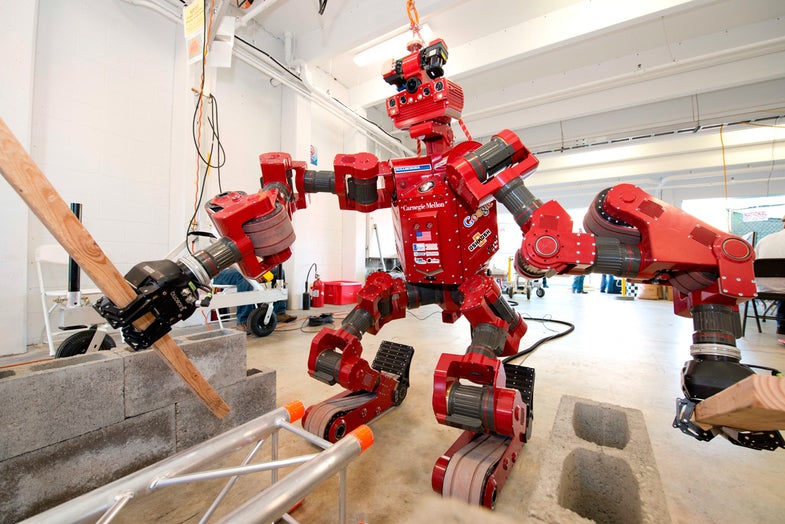Meet Chimp, A Disaster Response Robot With Four-Limb Drive
He's one of 25 robots competing in DARPA's Robotic Challenge this month

This month, 25 robots will traverse rubble, saw through walls, and drive a vehicle through a simulated disaster zone in the DARPA Robotics Challenge final showdown. The three-year competition–inspired by the Fukushima-Daiichi nuclear accident–is motivating the development of robotic technologies for use in hazardous environments. (A $2 million prize for the team behind the winning robot doesn’t hurt.) Just as the 2004 DARPA Grand Challenge led to self-driving-vehicle technology, this event could lead to dexterous robots for disaster response, advanced manufacturing, and warehouse automation.
A team at Carnegie Mellon University engineered its Highly Intelligent Mobile Platform, or Chimp, to excel in unpredictable terrain. “The greatest challenge of humanoid robots is balance,” says head of software Clark Haynes. “Chimp has static stability, so it’s never at risk of falling over and never actively balancing, because it doesn’t have to.”
How Chimp Works

Disaster-Ready Robot
Situational Awareness: Chimp can operate without human intervention but is most effective when it takes remote orders. Six cameras and lidar (like radar but with light) provide an operator with a 360-degree view of the robot’s surroundings.
Strategic Slouch: The robot’s shoulders angle slightly forward, rather than sit in line with its torso, giving its 4.3-foot-long arms additional reach. The design also makes it easier to fit Chimp’s stocky frame through doorways.
Rugged Mobility: Despite its humanoid “legs,” Chimp doesn’t walk. Instead, it rolls across terrain on rubberized tracks, like a tank. This reduces the risk of toppling over. In tough conditions, it can drop to all fours for more stability.
Autonomous Manipulation: Spotty communications prevent a robot from relying on humans to control its “hands.” Chimp can locate a valve or power tool with its computer vision, then use motion-planning algorithms to grasp and operate the object.
Efficient Balance: Chimp is statically stable, which means the robot doesn’t need to use energy (or special software) to stay balanced. To save even more juice, it locks joints that aren’t engaged. If the power is cut altogether, a parking brake freezes Chimp in place.
This article was originally published in the June 2015 issue of Popular Science, under the title “A Robot For Disaster Response.”